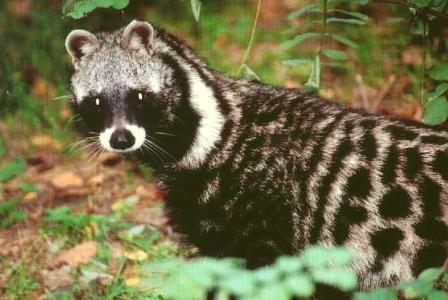


|
Viverridae:
The 32 species of civet, genet, and linsang make up the family Viverridae. They are small, lithe-bodied, mostly arboreal members of the order Carnivora. General appearance is broadly cat-like, but the muzzle is extended and often pointed, rather like an otter or a mongoose. The Civet's length, excluding its long tail, is about 17 to 28 in (400 to 700 mm) and its weight is about 3 to 10 lb (1 to 5 kg). Civet cat is an imprecise term that is used for a variety of cat-like creatures such as the Ringtail or North American Civet Cat (Bassariscus astutus), related to the raccoons; the musk-producing African Civet Cat (Civettictis civetta); Asian Leopard Cat (Prionailurus bengalensis — a true cat) and African Wildcat (Felis libyca — a true cat). The term is best avoided to prevent confusion among viverrids, racoons and cats. Although it resembles the other civets, the African Palm Civet (Nandinia binotata) is genetically distinct and belongs in its own monotypic family, the Nandiniidae. Furthermore, recent genetic research indicates that the Asiatic linsangs of the genus Prionodon are not true viverrids but rather more closely related to the Felidae. The Madagascan fossa Cryptoprocta ferox was similarly long thought to be a member of the Viverridae, but genetic evidence indicates that this animal is a member of an endemic Madagascan carnivore radiation related to the Herpestidae. Civets are omnivorous, supplementing a meat diet (both hunted and scavenged) with fruit, eggs, and possibly roots. One of the Common Palm Civet's favorite fruits is the coffee "berry." The coffee bean within often survives, and it is sometimes gathered and sold as caphe cut chon (fox-dung coffee) in Vietnam or Kopi Luwak (civet coffee) in Indonesia. |
